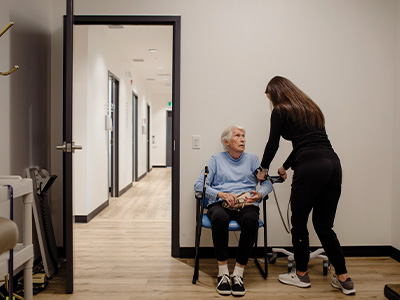Got Doc?

The pandemic laid bare the widening gaps in a health-care system that is battling the dual problems of lack of staffing and burnout. How do family doctors fit into the mix?
The acute crisis of the COVID-19 pandemic is over but as the dust settles, the chronic pressure points in the health-care system have been exposed.
More than two-million Ontarians are without a family doctor, and studies predict the shortage will get worse before it gets better. Older physicians are retiring, and their younger counterparts are taking on fewer patients, determined to create a work-life balance that seemed out of reach for their predecessors.
Family doctors are the backbone of the healthcare system. Studies show that a system with a robust, functioning family medicine system saves massive amounts of health-care dollars. That’s enabled medical schools such as Schulich School of Medicine & Dentistry to evolve its admission policies and curricula to admit and inspire a more diverse group of students to explore family medicine in new and exciting ways.
“We’re expanding spots within the School, pushing for a more generalist curriculum to create a broader scope, creating experiential learning in communities to see what that could look like as a career,” said Dr. Scott McKay, Chair of Family Medicine.
The Schulich Medicine & Dentistry solution
McKay believes more medical students will be inspired to enter family medicine, thanks to Schulich Medicine’s new teaching strategies, along with an increase in the number of training spots – the School will add 16 medical education spots this fall. As well, at least 15 new family medicine residency training spots are anticipated over the next several years.
 Making an impact at family medicine clinics.
Making an impact at family medicine clinics.
At the heart of these strategies is a more general approach to medical curriculum where “there is strong focus on a broader scope approach to medicine, rather than a very specific sub-specialty of knowledge,” said McKay. “This will allow students to see the potential of a career as a family physician, rather than honing in on one speciality.”
As well, experiential learning, where students are exposed early to family medicine, will motivate more students to choose it as a career, said McKay. Ten half-days spread out over the first year of medical training exposes students to family medicine. As well, Discovery Week caps off the first year of studies, where students spend several days in surrounding communities shadowing a family doctor.
“Our emphasis,” said McKay, “is on experience and a learner-focused, forward-thinking curriculum that will prepare our students for the complex needs of diverse and under-served communities. All of these initiatives will inspire more students to choose family medicine.”
The early results of these strategies are working.
At Schulich Medicine, 40 per cent of medical students chose to pursue family medicine compared to 30 per cent across Canada.
“We’re doing great at promoting family medicine as a viable career,” said McKay.
At the same time, a new Practice Ready Assessment Program developed by the provincial government and the College of Physicians and Surgeons of Ontario will allow practising international physicians to begin careers in Canada, which should help also relieve some of the shortages.
Thinking beyond grades
Medical students are shifting focus, looking at practising medicine more locally, or in smaller communities they might not have considered in the past, McKay said. Pandemic lockdowns and travel bans forced doctors, both new and old, to look closer at working in their own backyards.
“The pandemic might have forced people to see their own communities in a new light. This may be helping students consider a career in family medicine,” said McKay.
While academic performance is a critical element for entry, the admissions process at Schulich Medicine & Dentistry also considers the importance of a broader, more diverse cohort, with a process that opens the door for under-represented groups, such as students from rural areas or a lower socioeconomic status.
It gives special consideration to applicants from Indigenous communities, the Canadian Armed Forces, and those who have faced barriers on their path to applying to medical school.
Making a connection
Interest in family medicine lags behind some other streams. But those who do choose family medicine do so because they see the tremendous value of helping people in struggling or marginalized communities, of connecting with the people on a personal level and helping to stop health problems from spiralling.
“The family doctor is the vital link in a whole stream of health-care services in the community. For vulnerable patients, continuity of care can be a problem. That’s why we focus our training on interdisciplinary, team-based care.”
—Dr. Scott McKay
“The family doctor is the vital link in a whole stream of health-care services in the community,” said McKay. “For vulnerable patients, continuity of care can be a problem. That’s why we focus our training on interdisciplinary, team-based care.” At the post-graduate level, doctors are more likely to stay where they train, said McKay. This trend, along with more family medicine spots on-boarding in 2024, will lead to the creation of more residency sites in under-served regions. These regions include rural and northern regions, but also cities such as London, where an estimated 100,000 residents are without a family doctor.
In Windsor, for example, there’s been a 35 per cent increase in family physicians since the medical school campus first opened in 2008, and more than 80 per cent of graduates from the family medicine residency program have chosen to stay in Windsor-Essex.
Embracing challenges
Dr. Monty Hackett, MD’23, specializing in family medicine at Queen’s University and serves as president of the Canadian Federation of Medical Students, said he and his classmates are eager to help ease the shortage, but they do so aware of the challenges.
“My classmates and I talk all the time about the challenges of family medicine,” said Hackett. “We chat about the burdens placed on us, the aging population. We face nine to 12 hours of paperwork a week. In some cases, especially in rural areas, we can be stretched too thin, working 24-hour shifts.”
So, why would Hackett and his classmates choose family medicine?
“We make significant impacts on our community,” said Hackett. “We have a strong will and desire to help. We have significant needs in Canada, in our northern communities, in rural areas. London, too. There are needs for family medicine everywhere.”
The needs that Hackett points out can be addressed by the type of doctor Schulich Medicine is eager to train.
“I know that the School has worked tirelessly to bring in more diverse students and now we’re seeing the fruits of this shift,” said Hackett, who noted his graduating cohort was incredibly diverse and that the new curriculum, with its emphasis on doing and not simply knowing, is working to inspire more students to explore the privileges of family medicine.
Both McKay and Hackett believe that being a family doctor is one of the most unique professions on the planet.
“You’re there with families as they celebrate a newborn, you’re there through the tragedies, through death,” said McKay. “In a career you serve entire generations of families, it’s a career like no other, with endless variety and the ability to control and grow your interests.”








